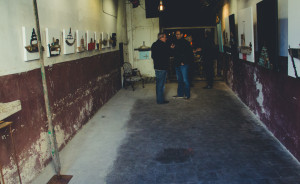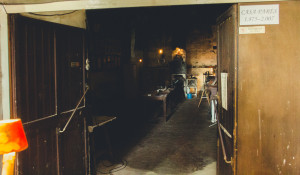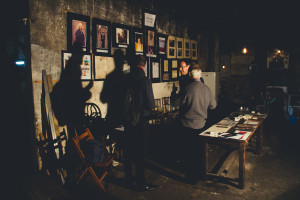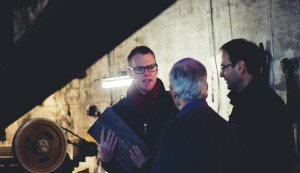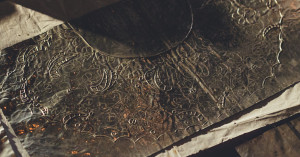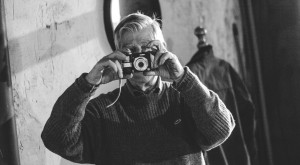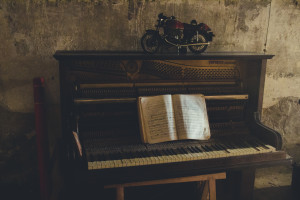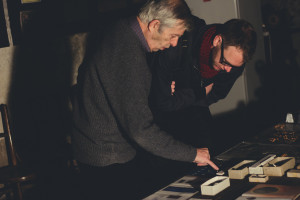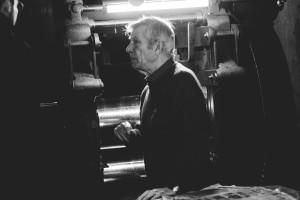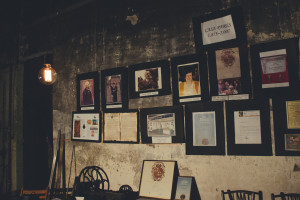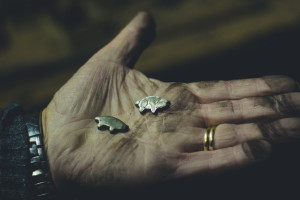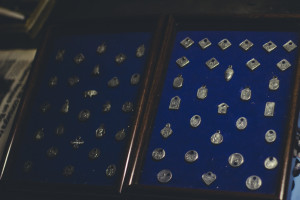I saw the video cameras, but I had no idea what was going on. There were news trucks and reporters congregating in front of one of the big brick buildings inside the renovated industrial complex. I walked over, somewhat timidly, to ask if they were shooting a film, but the answer was no. Then I left. It was around 4:00 pm on Sunday, May 24th and I was visiting Fabra i Coats for the first time.

Fabra i Coats, a great big old textile factory saved from destruction at the last minute.
Based on that date, some of you have probably already figured out what it was that I was witnessing, but I didn’t find out until 9 months later. That was when I went back to Fabra i Coats with my friend and colleague, Oriol, in order to talk about his thoughts on the musealization of Barcelona’s industrial heritage.
If you’ve never been, Fabra I Coats is perhaps the best-maintained historic textile factory complex in Barcelona. It’s located in the Sant Andreu neighborhood, an industrial zone/town that was later incorporated into the “grand Barcelona”, and only recently has been converted into a mixed-use space including a school, an contemporary art center and exposition area, spaces for various community associations, a Catalan language school, and a library.

The Fabra i Coats complex not including the library (above, off screen)
I first went to Fabra I Coats because, in 2015, the MUHBA (Museum of History of Barcelona) opened a site there in the “Sala del Calderas” (boiler room). What I found when I visited was not so much an exposition as it was a conservation project: a few descriptive panels and other media dotted the space, but these provided little contextualization or interpretation for the giant boilers and labyrinthine pipes, valves and vents that fill the basketball-court-sized room. You could visit too, the site is open to the public on Sunday mornings and the visit is free although in Catalan only.

The boiler room. An interesting place to visit for all boiler-lovers.
I have to talk a little bit about my friend Oriol. We met through the CEHIC (Center for the study of the History of Science at the Universitat de Barcelona) where we both study. Our first conversation centered on Oriol’s deep love of Barcelona and the legacy of its largely overlooked industrial past. Ok actually, come to think about it, every conversation I’ve had with Oriol has centered on these topics; he is just a guy with an uncontainable enthusiasm for this city and its urban memory.
In fact, one of the first thing he did when we met up outside Fabra I Coats was to warn me. I should know that he was no great expert on the issue, and he probably didn’t count as a neutral academic source of information. That was great news for me, I’ve read enough about the facts and I was ready for some feeling. Furthermore, my intuition leads me to suspect two things to be true: first, that Oriol’s feelings are shared by many people, and secondly, that these “collective feelings” merit an important agency in this story.

Manuel Delgado Ruiz, social anthropologist at the University of Barcelona, makes “collective feeling” the protagonist in this book “Eulogy for the Pedestrian: From the ‘model Barcelona’ to the real Barcelona”
“The Black City. That’s what they called it.” Oriol started his discourse at the beginning of the 20th Century when hundreds of active factory chimneys spouted ash over the Barcelona cityscape. But the adjective “Black” didn’t come from the ash, but rather from working class conflicts, uprisings, strikes, assassinations, and anarchism. If you were a rich politician from Madrid, you had to be careful when passing through Barcelona. You could get shot. A lot of people got shot.
On the positive side, the first 40 hour work week legislation in the world was passed in Barcelona. Ateneos, a type of associationism particular to Spain, thrived in Barcelona, increasing citizen agency in public affairs. New models of production and consumption such as collectives and cooperatives flourished in the city.
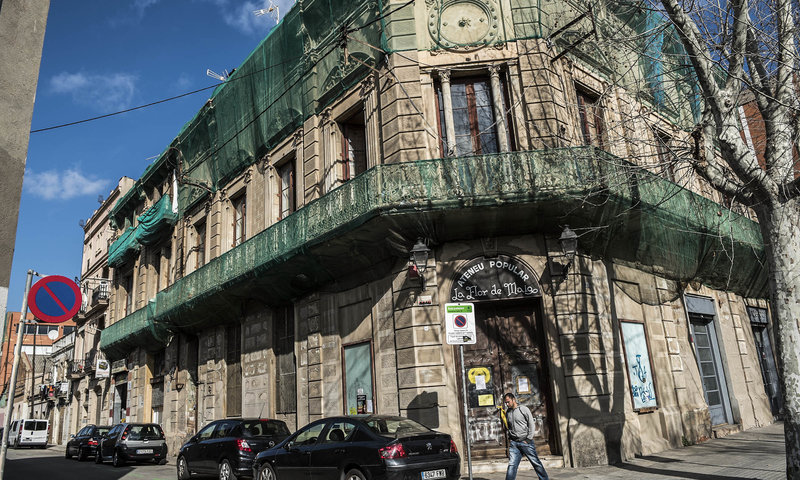
One of the most important cooperatives, Flor de Maig, originated in Poblenou and currently faces a conservation crisis.
The golden days of Barcelona’s industrial culture ended with the civil war. Franco’s tanks rumbled down la Diagonal and an oppressive fascist regime took control of the city. The Catalan language was outlawed as part of a broader cultural strategy aimed at erasing Catalan nationalist sentiment. This strategy also took the offensive: the building of new monuments to Franco’s Spain, and, as a more subtle strategy, the creation of symbols that reinforced the idea of a peaceful and unified Spain. Thus, the image of the idealic Catalan countryside, full of ancient and innocent folkloric traditions, became the official representation of local popular culture.
I took a moment to comment on Oriol’s story, noting that it was very politically charged. He totally agreed. “In Barcelona we still feel a strong sense of ‘Frontimso’” (literally, front-ism). I had never heard this wonderful word before, and Oriol explained that it comes from when two armies meet on the battlefront. The word means that people in Barcelona still have a sense that there are two sides, and they are at war.

“Frontismo”
Left – Right
Poor – Rich
Bottom-up – Top-down
Franco died in 1975, and the fascist regime came to an official end, but at the same time, it didn’t. The Amnesty Law of 1977 established a clean slate policy for the fascists ex-leaders, but what it didn’t do was bring a sense of closure for those who suffered under Franco’s regime. It was a law that essentially said that what had happened was to be forgotten. But apparently many people were not ready to forget.
There is another sense in which Barcelonans lack closure. Many people feel like certain elements of fascist Spain have, in practice, not changed post-Franco. According to Oriol, Catalan governance since the 1980’s has been rightist. The Catalan language has been restored as the official language of Barcelona, but in other aspects Franco’s cultural program has become today’s status quo. This explains why tensions are so high regarding the management of Barcelona’s industrial heritage: this is not just a heritage issue, it’s a cultural and a political one that is right at the heart of an old, conflictive, and painful topic: Catalan identity.
The neighbors in Sant Andreu that revindicated this history through their campaign to save Fabra I Coats from demolition did so despite huge obstacles. Their dedication to the task doesn’t make sense if you imagine that their only motivations were only towards the immediate context: against the planned housing development in favor of a new public library. These concerns only skim the surface of a deep, long-standing “frontismo”.
—
Oriol and I had made our way through the industrial complex to a large brick building. It was the same building I had stood beside 9 months earlier and seen the video cameras and reporters. Oriol had alluded to some significant event that had happened here, but he didn’t go into the details until we were right there standing in front of it. It turned out to be the part of the factory re-purposed as a free Catalan language school.
During the Barcelona’s municipal elections, held on May 24th, the winning candidate, Ada Colau, representing the radically leftist Barcelona En Comú political party, had used this site as the base of her voting-day operations. For Oriol, this was a highly symbolic act. Ada Colau represented a political tide-change from the previous era of conservatism. Her choice of Fabra I Coats linked her politics to a relic of the old, industrial Barcelona.
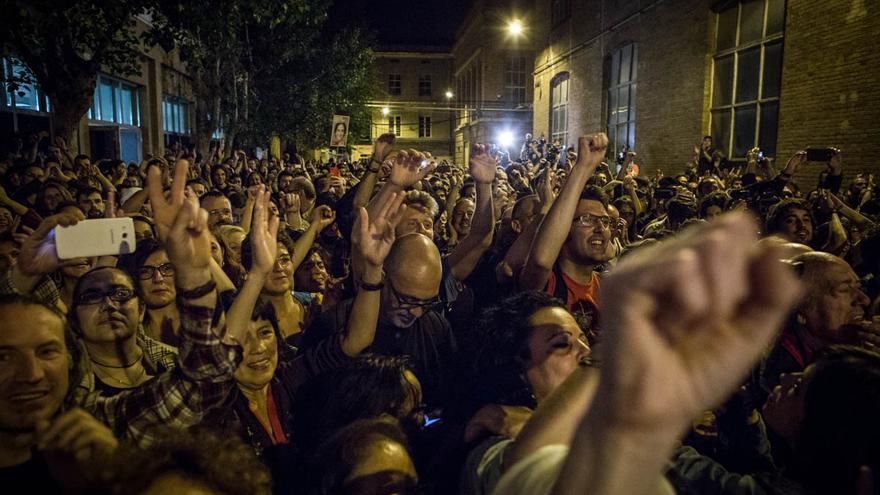
Celebrating Colau’s victory at Fabra i Coats. This must have happened a couple hours after I left, and I had no clue about any of it. Thanks for filling me in, Oriol!
Many industrial relics with characteristics similar to Fabra I Coats have been demolished over the past 30 years. Although many authors have understood and written about post-industrial urban transformation from the point of view of urban development, architectural production, and urban geography, talking with Oriol illuminated a political discourse that I find fascinating.
To what extent is “industrial culture” or “intangible industrial heritage” tied up with politics? I’ve heard of heritage resources classified as historical, social, technical, and aesthetic. But what about political heritage resources?
—
A month ago the ICUB (Instituto de Cultura de Barcelona) propelled a Festival of Popular Culture of Catalonia. This event took place over a weekend at Fabra I Coats and involved the participation of over a hundred cultural associations. I took an afternoon to go check it out. I had a wonderful time visiting the individual stands and expositions, but after some reflection I began to notice that something was missing.

Dances, music, festivals, and costumes. Flier from the Festival of Popular Culture.
There was no mention made of industrial culture. Everywhere I looked I saw the image of the idealic Catalan countryside filled with ancient, innocent, folkloric traditions: Castellers, Sardanas, pre-industrial weaving, choruses, and festivals. Everything was de-politicized. What would it look like to take a critical stance towards the politics of culture? I think that will be a necessary step if we hope to one day include industrial images alongside pre-industrial ones as part of Barcelona’s official culture.
For now it’s the black city.





